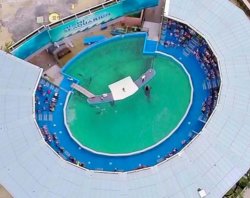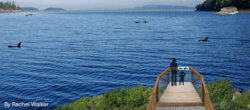By Naomi Rose
Virtually all of the larger captive cetaceans, particularly those from colder habitats (such as orcas and belugas), are held in concrete tanks, at least in North America. This type of wholly artificial enclosure appears to have significant negative impacts on the animals. For orcas, the impacts are especially overt and obvious: broken and worn teeth, diseases never found in free-ranging counterparts, shorter life spans, and most notably the collapsed dorsal fin seen in all males.

It’s very expensive to build a bigger tank, so ironically these largest of captive cetaceans are kept in comparatively tiny enclosures. And it should be intuitive to realize that these wide-ranging oceanic predators will suffer when confined in such small spaces. Aside from the physical and physiological damage noted above, captive orcas are also abnormal behaviorally and socially, in ways that are harmful to the animals in the long-term.
A seaside sanctuary can be larger – almost all sea pen dolphinarium facilities are much larger than any tanks, and a sanctuary will be larger still. In addition, a seaside sanctuary will be more natural for the cetaceans in them in so many other ways: acoustically, water quality-wise, in terms of other species (plant and animal) sharing the enclosure with them. In a seaside sanctuary, cetaceans will be able to swim in a straight line for some reasonable distance before meeting a barrier. (Even in the largest known tank, an orca can swim only a few body lengths before having to bank and turn along the outer wall of the tank.)

Artist’s rendering of seaside sanctuary as planned by the Whale Sanctuary Project.
They will also be able to dive deeper than in any known tank, which may be among the most important differences for them in a sanctuary. All cetaceans routinely dive below 30 feet in the wild, and most species might dive to more than 200-300 feet a few times a day. Yet no known tank is deeper than 30-35 feet. Given all the special adaptations these species have to allow them to dive so deeply, it should again be intuitive that never being able to dive as deep as they can will have negative impacts on the animals over time.
By their very nature, seaside sanctuaries are going to offer more choices, more challenges, and more stimulation to captive cetaceans. While cetaceans in sanctuaries will continue to be provided care, their human caregivers would, ideally, become less essential to their daily activities, simply because a seaside sanctuary will be more interesting than a barren concrete tank. I think what people often forget when considering the welfare and future of captive cetaceans is that in nature they do not need us. They are supreme in their natural habitat – top predators. We humans damage this independence and competence by confining these oceanic predators in tanks. Seaside sanctuaries cannot return that competence to them in its entirety, but they can give cetaceans an opportunity to regain some independence – or at least give them more control over their daily lives.
If seaside sanctuaries function as intended, eventually they will no longer hold any retired captive cetaceans. However, they will also serve as rehabilitation centers for stranded cetaceans, even during the period when they have ‘retirees’ as residents. And they will be able to serve this purpose in perpetuity.
We can’t undo all the harm we’ve inflicted on cetaceans by keeping them in captivity, but by providing them with seaside sanctuaries, we can improve their quality of life. That is our goal.
Naomi Rose is a member of the Board of the Whale Sanctuary Project.